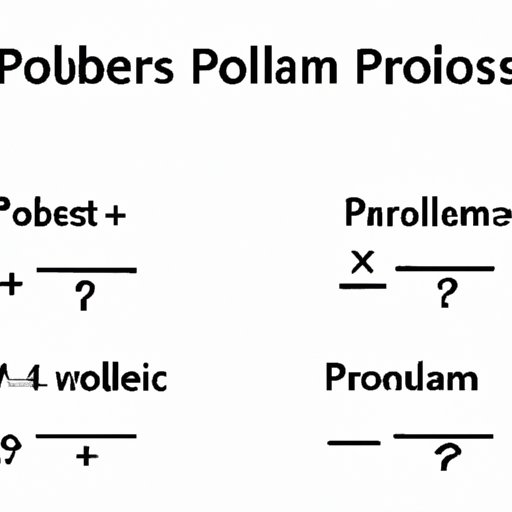Introduction
Word problems are mathematical problems written in a narrative form. They often present a situation that requires you to figure out what numbers need to be used in order to solve the problem. Word problems can be intimidating, but they don’t have to be. With the right approach, they can become much easier to tackle.
In this article, we will explore how to solve word problems step by step. We will look at different strategies that can be used to break down a word problem into manageable pieces. We will also discuss how to use formulas and algorithms to help you find the solution. Finally, we will look at some tips for double-checking your work.

Create a Visual Representation of the Problem
The first step in solving a word problem is to create a visual representation of the problem. This can be done with diagrams, graphs, or charts. By creating a visual representation of the problem, it can help you better understand the problem and make it easier to identify the key information needed to solve it.
Diagrams are useful for showing relationships between objects or concepts. For example, if you’re trying to solve a problem involving distances, you might draw a diagram to show the different distances involved. Graphs are useful for displaying numerical data, such as the amount of time it takes to complete a task. Charts can be used to compare different items or values, such as the cost of different products.
Break Down the Problem into Smaller Steps
Once you’ve created a visual representation of the problem, the next step is to break it down into smaller steps. This will help you focus on the individual pieces of the problem and make it easier to identify the key information needed to solve it. Start by looking for keywords or phrases that indicate what type of operation needs to be performed. This could include addition, subtraction, multiplication, or division.
Next, identify the numbers that need to be used in the problem. These may be provided directly in the problem or you may need to calculate them. Once you have identified the numbers, you can start working on each step of the problem one at a time.
Use Formulas or Algorithms
If the problem involves more complex calculations, you may need to use formulas or algorithms to help you find the solution. Formulas are equations that can be used to solve a specific type of problem. Common formulas include those for calculating area, volume, interest, or distance. Algorithms are sets of instructions that can be used to solve a problem. They involve breaking down a problem into smaller steps and then following a set of instructions to solve each step.
When using formulas or algorithms, it’s important to make sure that you’ve identified all the necessary information and that you’re using the correct formula or algorithm. You should also double-check your work to make sure that the answer you get makes sense.
Analyze the Results
After you’ve worked through the problem and come up with an answer, it’s important to analyze the results. Check to make sure that the answer makes sense and that it is accurate. If it doesn’t make sense or isn’t accurate, go back and re-examine your work. Make sure that you haven’t made any mistakes or missed any important information.
You may also need to make adjustments to your solution if it turns out to be inaccurate. For example, if you’re solving a problem involving time, you may need to adjust your solution if the original answer was off by a few minutes.
Double-Check Your Work
The final step in solving a word problem is to double-check your work. Go over your work one more time to make sure that you’ve followed all the steps correctly and that your answer makes sense. Make sure that you’ve checked all the numbers and formulas to make sure they’re correct. Also, verify that you’ve used the correct operations and that you’ve solved the problem correctly.
Conclusion
Solving word problems can seem daunting, but with the right approach it can be made much easier. By creating a visual representation of the problem, breaking it down into smaller steps, using formulas or algorithms, analyzing the results, and double-checking your work, you can confidently tackle any word problem. With practice, you’ll become more comfortable with problem-solving and will be able to solve word problems quickly and accurately.
(Note: Is this article not meeting your expectations? Do you have knowledge or insights to share? Unlock new opportunities and expand your reach by joining our authors team. Click Registration to join us and share your expertise with our readers.)
